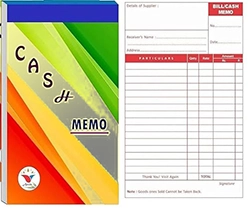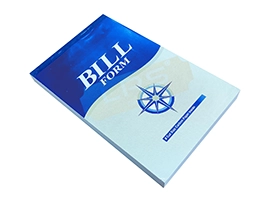Choosing the Best Notebook for Billing
In the modern business landscape, maintaining accurate records is essential. note book for billing have proven to be an effective tool for small businesses, freelancers, and even large organizations. They offer a straightforward way to document transactions and ensure financial accuracy. Below, a detailed guide on choosing the best notebook for billing is provided, incorporating essential components that should be included in any billing system.

BEST PICK
1. Bill Number
Each billing entry should include a unique bill number. This identifier simplifies the organization and retrieval of records. Notebooks with pre-printed bill numbers are preferred to avoid duplication.
2. Date of Issue
The date of issue must be included in every billing record. A notebook designed with a dedicated space for recording the date ensures chronological accuracy, which is critical for audits and financial tracking.
3. Time of Issue
Including the exact time of issue is essential for businesses that handle time-sensitive transactions. Billing notebooks with time slots or customizable fields are highly recommended.
4. Business Name
The name of the business should be prominently displayed on each page of the billing notebook. Notebooks with customizable headers allow this detail to be pre-printed, saving time during every transaction.
5. Business Logo
Branding is crucial for professional representation. A billing notebook that accommodates a pre-printed business logo enhances credibility and promotes brand identity.

BEST PICK
6. Address of Business
The physical address of the business must be included. Notebooks with space for this information ensure compliance with local regulations and improve customer trust.
7. Contact Details
Contact details, including phone numbers or email addresses, are often required. A billing notebook that reserves a section for this detail is highly functional.
8. Customer Name
Billing notebooks should include space to record the customer’s name. This feature is particularly useful for businesses with recurring customers or for those issuing personalized invoices.
9. Customer Contact
Notebooks with a designated area for recording customer contact details ensure seamless communication and follow-ups.
10. Customer Address
For businesses delivering goods or services, recording the customer’s address is vital. Billing notebooks with sufficient fields for this information are more versatile.
11. Invoice Number
While similar to the bill number, an invoice number serves as a unique reference for financial reporting. Notebooks with pre-numbered fields streamline this process.
12. Product Description
Billing notebooks must include space for detailed product descriptions. This ensures transparency and clarity for both the business and the customer.
13. Product Code or SKU
For businesses dealing with inventory, recording product codes or SKUs is essential. Billing notebooks with pre-formatted fields for such data minimize errors and simplify stock management.
14. Quantity
The number of items purchased should be recorded. A notebook with columns for quantity ensures that transactions are documented precisely.
15. Unit Price
The unit price of each product or service must be listed. Notebooks that feature structured templates for price details improve efficiency during the billing process.
16. Total Price per Product
The total price per product, calculated by multiplying the quantity by the unit price, should be clearly noted. Notebooks with pre-designed calculation rows simplify this step.
17. Subtotal
The subtotal, which represents the sum of all item prices before taxes and discounts, is a crucial component. Billing notebooks with subtotal rows make calculations easier and more accurate.
18. Discount
If discounts are applied, they must be recorded. Notebooks with space for discount details ensure transparency in billing.
19. Tax Percentage
The applicable tax percentage, such as GST or VAT, should be included. Billing notebooks that allow for manual entry of tax rates offer flexibility across different transactions.
20. Tax Amount
The total tax amount, calculated based on the subtotal and tax percentage, should be clearly stated. A notebook with tax calculation sections prevents mistakes.
21. Grand Total
The grand total, representing the final amount payable after discounts and taxes, is a vital component. Notebooks with designated areas for the grand total make the billing process smoother.
22. Payment Method
Recording the payment method (e.g., cash, card, or UPI) is essential for tracking transactions. Billing notebooks with checkboxes or dropdown-style fields are highly functional.
23. Amount Paid
The amount paid by the customer must be noted. Notebooks with dedicated fields for this information help track balances effectively.
24. Change Given
For cash transactions, recording the change given to the customer ensures accuracy. Billing notebooks with pre-printed sections for this detail are recommended.
25. Barcode or QR Code
While not always applicable, the inclusion of a barcode or QR code enhances traceability. Billing notebooks with QR code integration features are ideal for businesses embracing digital solutions.
26. Authorized Signature
A space for an authorized signature adds an extra layer of validation to the billing process. Notebooks that include this feature cater to businesses with strict documentation requirements.
27. Terms and Conditions
Billing notebooks that provide space for terms and conditions ensure that customers are informed about return and refund policies.
28. Return Policy
Including a return policy builds customer trust. Notebooks that allow businesses to pre-print these policies improve customer satisfaction.
29. Thank You Note
A thank-you note at the end of each billing entry adds a professional touch. Billing notebooks with customizable thank-you messages enhance customer relations.
30. Bill Footer
The bill footer is used for additional remarks, promotions, or greetings. Notebooks with this feature enable businesses to convey important information effectively.
Key Features to Look for in a Billing Notebook
When choosing note book for billing , several factors should be considered to ensure it meets business requirements. Features such as durability, pre-printed formats, and adequate space for essential components are critical. Notebooks with high-quality paper and binding improve usability and longevity.

BEST PICK
The second page of the billing notebook being empty can be utilized in several creative and practical ways, adding value to the product. Here are some of the most effective uses:
1. Notes for Record-Keeping
The blank page can be used to jot down extra details about the transaction, such as:
- Customer-specific requirements
- Special discounts or negotiations
- Follow-up reminders for pending payments
2. Receipts or Manual Calculations
The blank page provides space for:
- Writing down additional calculations
- Issuing handwritten receipts for special requests or adjustments
3. Advertising and Promotions
Businesses can use the blank side to:
- Print their promotional messages, such as new offers or upcoming events.
- Display QR codes linking to their website or social media pages.
4. Record of Daily Summaries
The empty page could serve as a logbook to summarize daily transactions, total sales, and cash in hand.
5. Customized Branding
The empty page could carry pre-printed:
- Motivational quotes related to the business.
- A large version of the company logo to reinforce branding.
6. Creative Engagement
It can be used to:
- Add a thank-you note or special greetings for customers.
- Encourage customers to provide feedback or reviews by mentioning contact details.
Would you like me to include these ideas in the existing article, or create a new write-up focused solely on these blank-page uses?

BEST PICK
Advantages of Using Billing Notebooks
- Ease of Use: Billing notebooks are simple to use, making them suitable for businesses with minimal technical expertise.
- Cost-Effectiveness: They are more affordable than digital billing systems.
- Portability: Notebooks can be easily carried, making them ideal for on-the-go transactions.
- Record Maintenance: Handwritten records can serve as a backup for digital data.
Conclusion
Choosing the right notebook for billing ensures that financial transactions are recorded accurately and professionally. By selecting a notebook that includes the components listed above, businesses can improve efficiency and maintain transparent records. Billing notebooks remain a reliable tool for many businesses, offering simplicity, portability, and effectiveness.
